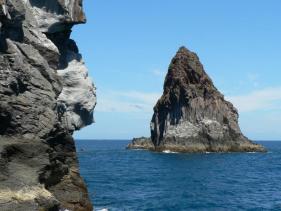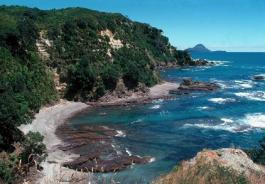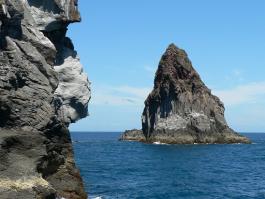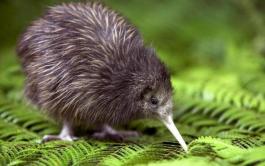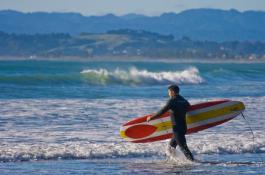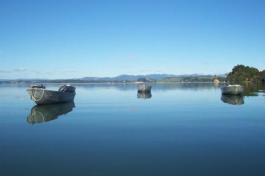View local Ohope Beach Attractions with Google Street View here!
Click here to view Ohope Beach Activity & Attraction Operators.
Click here for....
Diving to the west of Whakatane
Diving to the west out of Whakatane covers an area of the Bay of Plenty from Motiti Island, 35NM to the west to Mayor Island, 65NM to the west. The western area includes the legendary Tuhua Reef, Aotrolala Reef and Penguin Shoals. Of huge interest is the wreck of the Taioma at Motiti Island in 27m of water.
The Rurima Islands
Nearer to the port of Whakatane are the Rurima Islands, 9NM NW of Whakatane. A rocky reef area that offers great seafood like Mussels, Crayfish and Kina. The water is clear in mid-summer and the Rurima Islands will deliver exceptionally colourful and interesting diving. Photographers go nuts when they see the usually murky waters come clear. The colour comes from plants growing in the bad light and has to be seen to be believed. There are positively hundreds of safe shallow dives up to 30m in the huge area of reefs. The Rurima Islands also have some underwater volcanic activity and hold the secrets of the SS.Tasman.
The SS Tasman hit the SW reef in 1912, ran towards Matata and only made it a few miles before she finally sank in 27m of water. Little remains of the wooden ship, only a boiler, some anchor gear, the back bone and motors. The Tasman Reef was named after this accident.
Whale Island and inshore dives
Whale Island lays 4NM to the east of the Rurimas and is only 4.5NM from Whakatane. The Whale offers diverse diving from pinnacles to boulder dives in kelp beds. Follow the low drop offs and if you are lucky a scallop or two will find you. In the season of course! Crayfish is common there and spears can be seen snorkelling for a big Snapper or Kingfish.
Diving off the Whakatane heads and Kohi Point can offer some great diving but, due to the river, the water is often murky of 1m visibility or less. The diving is shallow up to 10m and ocean swells often stir up the silt bottom.
Waiotahi Reefs to the east of Whakatane is similarly silty but on a clear day can be fantastic.
Diving an island Volcano 'White Island' and the Volkner Rocks.
White Island (Whakaari) and the near by Volkner rocks (Te Pae Pae Aotea) offer some of the best diving in New Zealand. Everything from Pinnacles to drop-offs, boulder banks and archways, hot volcanic spots and sand plateaus. This combined with a huge abundance of brightly coloured fish such as Mau Mau, Tevally, Sweep, Mackerel, Koheru, Kingfish and Pamoiselles to name a few. There are the rare species like Banded Perch, Surgeon fish, Coral Trout, Knife fish, Banded Coral Shrimp, Snapping Shrimp, Pack horse Crayfish, Scallops and Blue Moki.
Club Rocks is only 400m from White Island and is a hugely diverse area where, in the one dive, you can expect to see dozens of species, Soft Coral Sponges and lots of fish including Golden Snapper.
A lot of the species at White Island are residents and need to be preserved. Moray Eels of different species are common with the Yellow-Mosaic Moray the most common. Huge Stingrays and Eagle Rays make diving White Island and Club Rocks a fabulous place to dive. One never seems to have enough air when diving White Island.
Laison's Reef named after Henry Laison is midway between White Island and the Volkner Rocks and is an awesome dive. The reef comes out of 150m of water right up to 13m. Fabulous visibility and I have seen it at 40m! Yes 130ft of visibility at times.
The 26 Fathom is a dive only for the true pro-divers. It's a small pinnacle a mile south of Laison's Reef. It boasts some huge Cup Sponges, Black Coral, and Enormous Kingfish. Only experienced and well prepared divers should attempt this dive. Physiological dangers can affect all divers if taken lightly.
Volkner Rocks Marine Reserve
Te Paepae Aotea ( Volkner Rocks ) consist of three andesitic rock stacks or pinnacles that rise to approximately 113 metres above sea level. The pinnacles are geologically linked to the active andesitic volcano of White Island. Large schools of pelagic and reef fish are found within the boundaries of the marine reserve and some species are locally rare due to the unique convergence of oceanic and subtropical currents at this southern location. This is a also place of great significance to Ngāti Awa and other iwi of the Mātaatua waka. It is the departure place for the spirits of all people from Mātaatua iwi.

